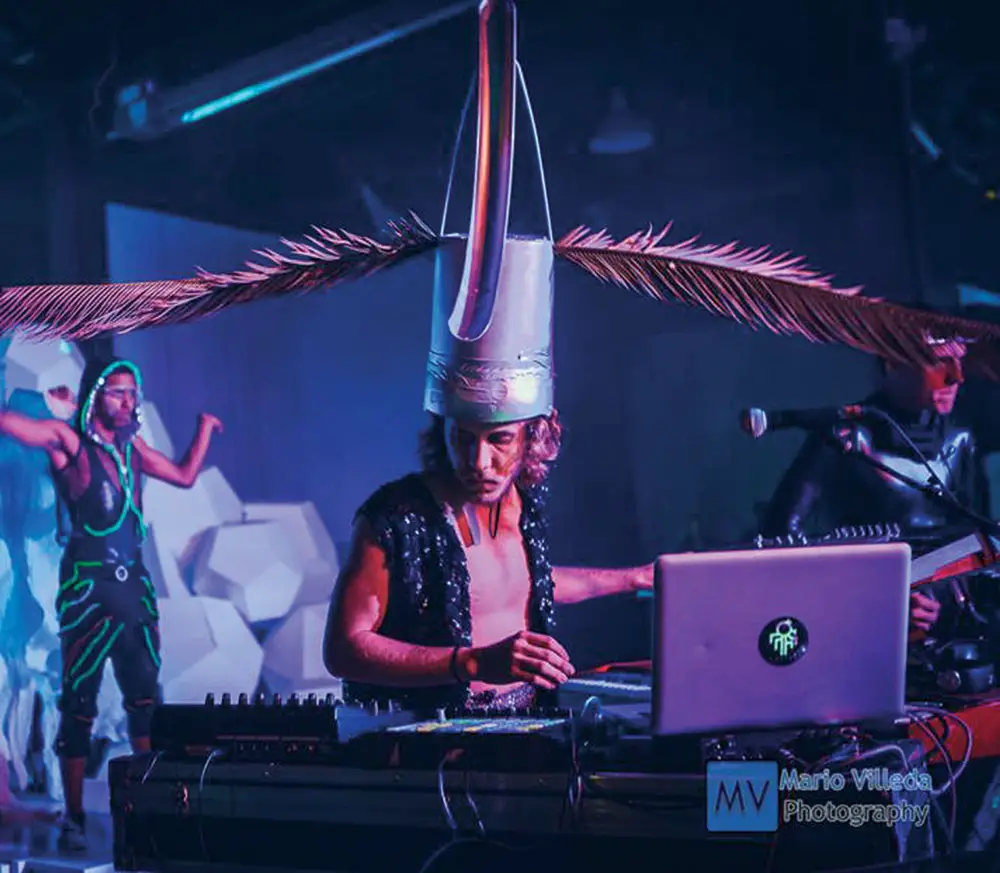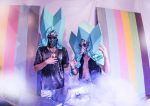The first time I saw Capyac perform was at the Royal House Co-op in a rickety living room with sticky wooden floors and the furniture pushed into the kitchen.
The two members of the band — Delwin Campbell and Eric Peana — were wearing get-ups pulled from a Giorgio A. Tsoukalos role-playing fantasy gone wrong, a blend of pharaonic dress and “Intergalactic” cosplay.
The stage, a generous description for a doormat, was inches away from the crowd and swamped by the band’s glittering starry night robes. On their heads were massive cornflower blue nemes that were plucked right out of D.I.Y. “Avatar” drag show.
At one point, Campbell and Peana looped the music, left the stage and disappeared into the crowd, which — despite the lack of musicians — continued moving and jerking like a decapitated chicken still kicking. It was the band’s going-away show before they left for a month of research with the Brazilian Antarctic Program (not really), and they wanted to dance.
Both musicians originally come from a jazz background: Peana played stand-up bass at the University of North Texas and Campbell, a UT Linguistics graduate, has been playing jazz piano since he was 14. And while their music doesn’t sound like jazz, a lot of the same tendencies are there, especially their affinity for improv.
It’s common for jazz musicians to take the bass line for a walk or tickle out the treble, but spontaneity in the dance scene is a rara avis. Most dance songs hold to predictable, pre-recorded sound loops that are musical versions of the coming Singularity: machines replacing unnecessary humans.
As a result, Capyac has run into trouble with inexperienced soundmen trying to navigate their ad-libbing. This makes the off-the-cuff riffs risky, but no riskier than the tedium of playing monotonous sets: talented musicians like Campbell and Peana get bored easily, so they take it upon themselves to make it difficult.
And while “improv” may sound like musicianspeak for “unprepared,” Campbell and Peana actually put hundreds of man-hours into preparing for every show. In fact — just so that we’re crystal clear about their work ethic — they put much more preparation into their shows than any band I’ve ever seen—and I’ve been to a Mannheim Steamroller concert.
“We say we play dance music,” says Peana, “because that’s what ties everything together. But it’s the movement and involvement that’s really important to us. That’s why we put in 12, 16-hour days working on music, and then go out and play shows at night.”
As a result, they’ve ensured that very little shoegazing goes on at Capyac shows, let alone nugazing, or even headbobbing. They construct the shows — construct them — with a focus on kinetic energy. Their performances are high-key, energy-intensive affairs, the kind of event that you go to wearing clothes that you’re okay with ruining, or ripping or getting ripped or waking up without. They’re what baby dance parties want to be when they grow up: the Platonic ideal, the one percent, the Jay Gatsby of dance parties.
“We just want people to dance and not care. Maybe that’s why we dress so weird,” says Peana, adding, “so that people can get past their own insecurities. We want people to look at us and say, ‘They look stupid, so I don’t care if I look stupid.’”
Their costumes — one of which Campbell described with loose historical accuracy as “Ottoman Empire explores Polynesia” — are a large part of that effort. They wear handmade, extravagant pieces, one part thrift-store salmagundi and two parts papier mâché. The clothes-as-props technique eases the crowd into the atmosphere, narcotically lowering their inhibitions and slipping them into a surreal, “Midsummer Night’s Dream” type vibe.
“I definitely come from an arts and sculpture background,” says Peana. “For the longest time I was convinced I was going to be a painter, so I’m always looking for ways to manifest that in our music.”
But it’s not just on set: several hours before they played at The North Door in Austin, Campbell and Peana were sitting in their South Lamar studio preparing for the show.
Peana was wearing tapered gold pants and a floral-embroidered white-linen shirt, while Campbell wore a buccaneer button-up with a twice-looped belt and jeans so long that he rolled them up nearly to his knees. That was their lounge-ware.
“Men’s fashion is something that’s super interesting to me,” says Campbell. “It’s kind of the same idea as our sets — why not?
I never once thought about why we would go through all this effort to make these things.”
As it turns out, what they wear to shows isn’t much of a departure from what they just, well, wear. Their closet could have doubled as a Halloween store: in it hung a wetsuit, a cheetah print button-up, disorienting patterns with shirts on them and a black and gold evening robe.
Peana changed outfits probably six times within an hour, fast walking to his closet to change and then returning to a bag of black balloons lying on the carpet. As he talked, he inflated the balloons and then pinned them to an upright wooden pallet, creating a rubbery wall of pointillist black. “We like to experiment with textures a lot,” said Campbell, “especially anything bumpy.”
Like their clothes, bizarre props are a hallmark of Capyac shows.
“We just made this huge thing that looks like a hand with six fingers,” says Peana. “It doesn’t look heavy but it must weight a hundred pounds. That was definitely one of the misfires.”
Fire or misfire, Campbell and Peana are set on making their stage a gallery, not just a platform.
“The last show we spent like $900 on [props],” says Campbell. “We built a giant silver pyramid, huge rainbow walls and then hired a video crew to film it.”
That night, Capyac was part of the lineup for an event called FEVER, a fundraiser benefitting an LGBTQ empowerment group called The Q.
Glitter, glisten, shake and sweat were a few of the buzzwords surrounding the event, so instead of trying to out-fabulous the bedazzled and be-speedoed crowd, Peana and Campbell tried something new.
Instead of their standard set — one already punctuated with improv — they decided to play remixes of their songs and ad-lib everything else. Instead of dressing flamboyantly, they subdued their ensembles and used only diet props. In other words, Capyac gave austerity a chance.
Secretly, I’d been hoping to see something like this. I wanted to see how Capyac would be received without their trademark theatrics. On the surface, it seemed like a bad idea, toning down their show after being recruited as a high-intensity act.
It also seemed like the venue might work against them. The North Door is a two-story space strung and strapped in sheet metal, with cement floors so prime for echolocation that a bat would mistake it for a house of mirrors. Compared to the Royal House Co-op, playing The North Door felt like dropping a goldfish into the ocean.
A football coach once gave me some of the worst advice ever. “If you’re going to make a mistake,” he said, “make it at full speed.” Coach Maldonado must have been in soundcheck with Capyac, because when they started playing they were moving about a thousand times faster than anyone else. Whatever happened, they weren’t going to fail for lack of energy.
Peana played bent at the waist nearly 90-degrees over his guitar, writhing like a broken doll being yanked up and down by a string. Campbell’s face was hidden by his Aslan mop but his fingers danced the length of the piano. The twosome radiated energy but the crowd just absorbed it, standing in receptive ambivalence. The Great Experiment looked to be failing.
But Capyac kept going. The first noticeable change was when the professional dancers outlining the room slowed down their own pulsing to watch Campbell and Peana’s, as if impressed by their endurance. A few crowd pioneers who had been dancing the entire time — more spectacle than example, though — began to seem a little less outlandish.
The audience clustered more closely and slowly approached the stage en masse. One show promoter called to the outside patio to come inside, and others who had been loitering throughout the gallery began filing toward the stage.
Capyac continued on in perfect form, as they had been the entire time.
Campbell and Peana moved nearly in tandem, still exchanging furtive glances and sparse words with each other to plot their improv as they played it.
Nothing had changed about their performance except its reception: now the entire crowd was dancing.
A bachelorette party was piggybacking through the crowd and two nude dancers were doing a Siegfried and Roy tiger-and-whip shtick in front of the stage. The room was a haze of sweat and glitter and rubber, and the mist from the fog machine smelled like Lone Star.
It felt like everyone was staring at the stage, as if noticing the band for the first time. I think they were impressed by the amount of energy that the two slim white guys were able to create. Whatever the reason, people couldn’t stop looking at Capyac. Earlier, Campbell had talked about dealing with this.
“Sometimes you feel like they’re eating you with their eyes,” he said. “Sometimes we do something and it doesn’t quite land, but you have to keep moving or they’ll see. You’ve got to tell them, ‘I’m not dinner tonight. You’re not eating me.’”










